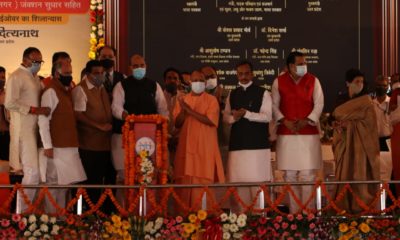Feature
India’s central bank cuts keys rates, stock indices hit historic highs

Mumbai: In a surprise development that sent stock markets soaring, India’s central bank cut its key lending rates by 25 basis points on Wednesday, expecting inflation to soften in the coming fiscal even as it expressed concern over the postponement of fiscal consolidation by a year.
Getting some positive cues from the national budget tabled last week, and sensing an economic recovery, the repurchase (repo) rate has been cut to 7.5 percent from 7.75 percent, while the reverse repo rate has been adjusted to 6.5 percent from 6.75 percent.
The rate cuts immediately follow a far-reaching agreement between the government and the Reserve Bank on Monday, under which the central bank will aim to bring the country’s retail inflation below the 6-percent mark by January 2016 and to around 4 percent by the end of 2016-17.
The announcement, which came just ahead of the opening bell for stock markets, brought much cheer to sentiments, prompting the sensitive index (Sensex) of the Bombay Stock Exchange to open nearly 345 points higher, over the previous close at 29,593.73 points.
The key index soon breached the 30,000-point mark to touch a historic high of 30,024.74 points, and was ruling at around 29,890 points around 30-minute into trading, with a gain of 300 points or 1 percent.
The situation was similar at the National Stock Exchange, where the Nifty also hit an all-time high.
“To summarise, softer readings on inflation are expected to come in through the first half of 2015-16 before firming up to below 6 percent in the second half,” Reserve Bank of Governor Raghuram G. Rajan said in a statement.
“The fiscal consolidation programme, while delayed, may compensate in quality, especially if state governments are cooperative,” said the governor who has otherwise been taking a rather conservative approach in dealing with the monetary policy, especially the interest rates.
“Given low capacity utilisation and still-weak indicators of production and credit off-take, it is appropriate for the Reserve Bank to be pre-emptive in its policy action to utilise available space for monetary accommodation.”
The repurchase rate is the interest commercial banks pay for borrowing money from the central bank to meet short-term fund requirements. The reverse repurchase rate is the interest central bank pays when surplus short-term funds are parked with it by banks.
In its monetary policy statement of Jan 15, 2015 the Reserve Bank had reduced the repo rate by 25 basis points, and said: “Key to further easing are data that confirm continuing disinflationary pressures.”
But it maintained its interest rate stance in its sixth bi-monthly monetary policy statement of Feb 3 in the absence of new developments on inflation or on the fiscal outlook, awaiting signals on that count and from the national budget.
While the next bi-monthly policy statement will be issued April 7, 2015 the still weak state of some sectors and the global trends, prompted the central bank, in its own admission, to become more anticipatory to make changes immediate in its stand.
In his statement on Wednesday, Rajan also lauded the Central Statistics Office (CSO) for the changes it made in the national income accounting, on which is based the country’s gross domestic product estimation, to bring it up to international standards.
“Yet the picture it presents of a robust economy, with growth having picked up significantly over the last three years, is at odds with still-low direct measures of growth of production, credit, imports and capacity utilisation as well as anecdotal evidence on economic cycle,” he said.
“Nevertheless, the picture of a steadily recovering economy appears right,” he added.
“Going forward, the RBI will seek to bring the inflation rate to the mid-point of the band of 4 percent (plus or minus 2 percentage points) provided for in the agreement, that is to 4 percent by the end of a two-year period starting fiscal year 2016-17.”
Entertainment
Meghalaya Reserves Legalized Gambling and Sports Betting for Tourists

The State Scores Extra High on Gaming-Friendly Industry Index
Meghalaya scored 92.85 out of 100 possible points in a Gaming Industry Index and proved to be India’s most gaming-friendly state following its recent profound legislation changes over the field allowing land-based and online gaming, including games of chance, under a licensing regime.
The index by the UK India Business Council (UKIBC) uses a scale of 0 to 100 to measure the level of legalisation on gambling and betting achieved by a state based on the scores over a set of seven different games – lottery, horse racing, betting on sports, poker, rummy, casino and fantasy sports
Starting from February last year, Meghalaya became the third state in India’s northeast to legalise gambling and betting after Sikkim and Nagaland. After consultations with the UKIBC, the state proceeded with the adoption of the Meghalaya Regulation of Gaming Act, 2021 and the nullification of the Meghalaya Prevention of Gambling Act, 1970. Subsequently in December, the Meghalaya Regulation of Gaming Rules, 2021 were notified and came into force.
All for the Tourists
The move to legalise and license various forms of offline and online betting and gambling in Meghalaya is aimed at boosting tourism and creating jobs, and altogether raising taxation revenues for the northeastern state. At the same time, the opportunities to bet and gamble legally will be reserved only for tourists and visitors.
“We came out with a Gaming Act and subsequently framed the Regulation of Gaming Rules, 2021. The government will accordingly issue licenses to operate games of skill and chance, both online and offline,” said James P. K. Sangma, Meghalaya State Law and Taxation Minister speaking in the capital city of Shillong. “But the legalized gambling and gaming will only be for tourists and not residents of Meghalaya,” he continued.
To be allowed to play, tourists and people visiting the state for work or business purposes will have to prove their non-resident status by presenting appropriate documents, in a process similar to a bank KYC (Know Your Customer) procedure.
Meghalaya Reaches Out to a Vast Market
With 140 millions of people in India estimated to bet regularly on sports, and a total of 370 million desi bettors around prominent sporting events, as per data from one of the latest reports by Esse N Videri, Meghalaya is set to reach out and take a piece of a vast market.
Estimates on the financial value of India’s sports betting market, combined across all types of offline channels and online sports and cricket predictions and betting platforms, speak about amounts between $130 and $150 billion (roughly between ₹9.7 and ₹11.5 lakh crore).
Andhra Pradesh, Telangana and Delhi are shown to deliver the highest number of bettors and Meghalaya can count on substantial tourists flow from their betting circles. The sports betting communities of Karnataka, Maharashtra, Uttar Pradesh and Haryana are also not to be underestimated.
Among the sports, cricket is most popular, registering 68 percent of the total bet count analyzed by Esse N Videri. Football takes second position with 11 percent of the bets, followed by betting on FIFA at 7 percent and on eCricket at 5 percent. The last position in the Top 5 of popular sports for betting in India is taken by tennis with 3 percent of the bet count.
Local Citizens will Still have Their Teer Betting
Meghalaya residents will still be permitted to participate in teer betting over arrow-shooting results. Teer is a traditional method of gambling, somewhat similar to a lottery draw, and held under the rules of the Meghalaya Regulation of the Game of Arrow Shooting and the Sale of Teer Tickets Act, 2018.
Teer includes bettors wagering on the number of arrows that reach the target which is placed about 50 meters away from a team of 20 archers positioned in a semicircle.
The archers shoot volleys of arrows at the target for ten minutes, and players place their bets choosing a number between 0 and 99 trying to guess the last two digits of the number of arrows that successfully pierce the target.
If, for example, the number of hits is 256, anyone who has bet on 56 wins an amount eight times bigger than their wager.























